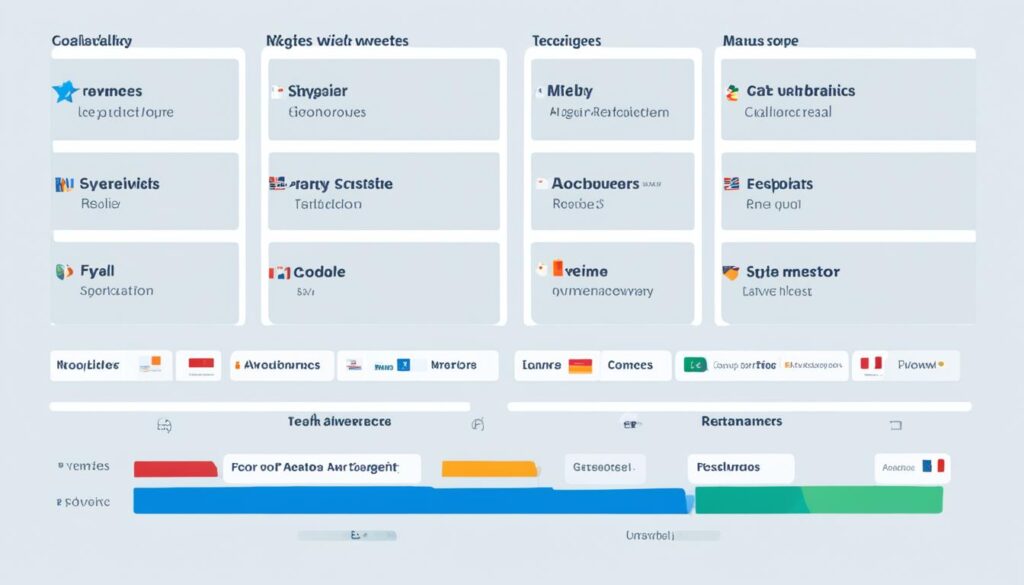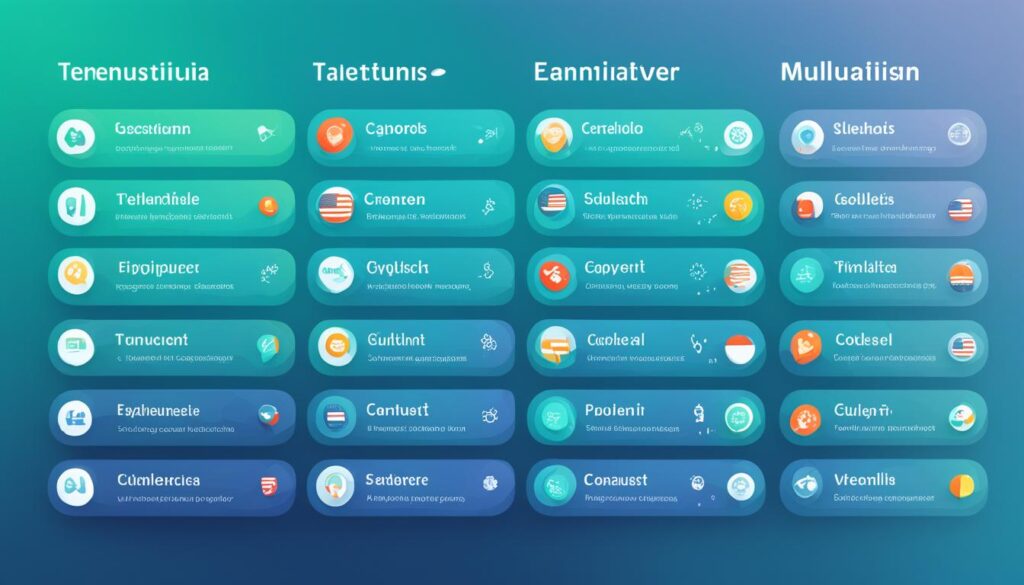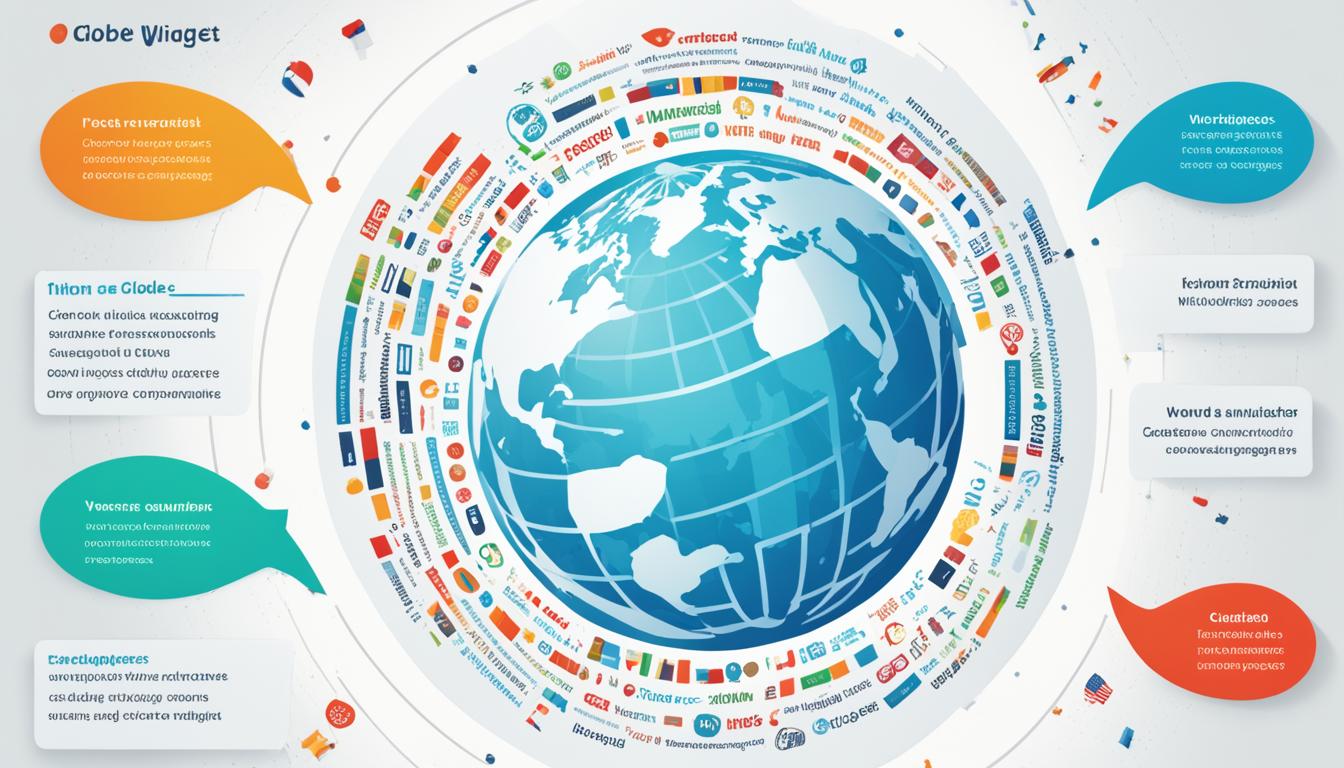Have you ever thought about how businesses reach out to customers worldwide? In today’s connected world, making review widgets available in many languages is key. We’re exploring how widget code and reaching out to different people help with this.
https://www.youtube.com/watch?v=Ah6oc-vNzHU
Offering content in many languages is more than just a bonus; it’s a strong way to grow your audience. By supporting many languages, companies can draw in customers who might have missed their content before1.
Our support team knows that people connect more with content in their own language. This means happier customers and a stronger bond between the brand and its audience1.
Did you know that websites in many languages can also help with search engine rankings? By reaching out to different people, you’re not just getting more views. You’re also getting more visitors from around the world1.
With tools like TranslatePress, making your site easy to translate is simple. This plugin makes sure everything on your site gets translated well, helping your SEO and reaching more people1.
For businesses aiming for a global audience, ConveyThis is a great choice. It supports over 110 languages and works with popular sites like WordPress, Shopify, and BigCommerce2. This means you can connect with people from all over the world.
Key Takeaways
- Multilingual support makes users more engaged and trusting
- Translated content helps with SEO and visibility
- TranslatePress provides full translation solutions
- ConveyThis supports over 110 languages on various platforms
- Custom language options make users happier
- Multilingual widgets help reach a wide global audience
- Language support is key for growing internationally
Understanding the Importance of Multilingual Review Widgets
Multilingual review widgets are key in today’s global market. They help businesses reach a wider audience and increase their earnings. With 41 percent of consumers saying reviews are crucial when picking a local business, it’s clear feedback is powerful3.
Companies with more reviews than their rivals earn 54 percent more each year3. This shows the value of adding multilingual support to your review plan. It’s not just about having more reviews. The quality and ease of reading them also count.
English is used by only 25.9 percent of Internet users worldwide, while Chinese languages are second with 19.4 percent3. In the U.S., 13 percent speak Spanish at home3. These numbers show the need for review widgets that support many languages.
Using the customer’s native language builds trust. 29 percent of consumers feel more confident with brands that speak their language3. This confidence can lead to more engagement and trust, especially when writing reviews.
| Factor | Percentage |
|---|---|
| Consumers who post reviews monthly | 47% |
| Likelihood of review after positive experience (with request) | 53% |
To get the most from multilingual review widgets, focus on SEO for each language and use separate URLs for each version4. This strategy helps avoid duplicate content issues and boosts visibility in local search engines.
Offering a consistent experience in different languages builds trust with visitors from around the world4. A well-planned approach to asking for reviews in multiple languages can greatly increase customer interaction. This can lead to higher earnings for your business.
The Impact of Multilingual Support on Customer Feedback
Multilingual support for review widgets is key in today’s global market. It lets businesses reach out to people all over the world. This makes customers trust and stick with the brand more.
Our studies show that shopping in one’s own language can really help sales and build stronger bonds5. When customers can write reviews in their own language, they give more detailed feedback. This kind of feedback is gold for businesses looking to get better at what they do.
Adding support for many languages shows a brand cares about its customers. This approach builds trust and can lead to more growth6. Brands that speak many languages often get more sales questions than those that don’t7.
Customers are more likely to come back if they got help in their own language after buying7. Keeping customers happy is key, as it’s cheaper to keep them than to find new ones. By making reviews in many languages, businesses can reach more people and make customers happier.
“Multilingual support increases brand loyalty and separates businesses from their competition.”
In the end, multilingual support for review widgets is a must-have for businesses wanting to grow worldwide. It helps companies reach new markets, improve customer experiences, and grow in a connected world.
Key Features of Multilingual Support for Review Widgets
Multilingual support for review widgets makes websites more user-friendly and reaches a wider audience. You can easily change the default language to meet the needs of different customers. This flexibility helps businesses connect with people from around the world.
Customizing email templates in various languages is a key feature. It ensures that users get clear and consistent messages, no matter their language. By matching the widget language with the user’s choice, browsing becomes smooth and enjoyable.

Some review widgets support up to 133 languages, making them perfect for global use8. This wide language support helps businesses engage with more people and boost interaction in different regions.
Working with popular multilingual plugins is another big plus. For example, Site Reviews is compatible with Polylang and WPML. This means reviews can be easily shared across all languages of a website9.
| Feature | Benefit |
|---|---|
| Customizable email templates | Consistent communication in user’s language |
| Multiple language support | Wider global reach and engagement |
| Integration with multilingual plugins | Consistent review display across languages |
| Right-to-Left (RTL) support | Proper alignment for languages like Arabic |
However, adding multilingual support can be tricky. For example, translating reviews from custom tables is complex9. But, developers are finding new solutions, like AI for on-the-fly translations. These efforts aim to make multilingual review widgets work better for everyone.
Implementing Multilingual Support for Review Widgets
Setting up multilingual support for review widgets is key to reaching a wide audience. We’ll show you how to do it with popular tools and best practices.
First, pick a plugin with strong multilingual features. Many e-commerce sites like Yotpo Reviews support translations to many languages for on-site widgets10. This helps you serve customers worldwide.

To start, go to your general settings and look for language options. In Yotpo Reviews, just pick a language from a dropdown menu10. This easy step turns on multilingual support for your review widgets.
When setting up multilingual support, think about these important points:
- Supported languages: Make sure your tool supports all languages your customers speak.
- Integration: Check if it works well with your website.
- Translation quality: Some tools use community translations, so you might need to fix new phrases sometimes10.
Setting up multilingual support is not just a one-time job. It needs ongoing care. If you find untranslated items, contact support with screenshots and the right translations for quick fixes10.
Some platforms automatically translate based on where your customers are from. Others need you to set it up manually. For example, some plugins let you choose which language reviews go to on multilingual pages9. This way, your review widgets will show up right for each language on your site.
| Feature | Benefit |
|---|---|
| Automatic translation | Saves time, reduces manual effort |
| Manual language assignment | Precise control over review display |
| On-the-fly translations | Real-time language adaptation |
By following these steps and thinking about these points, you’ll get your review widgets ready for many languages. This will make your site better for users in different languages.
Best Practices for Optimizing Multilingual Review Widgets

Did you know 62% of people find online reviews really useful? And 46% trust them as much as personal advice11. Let’s dive into how to make the most of multilingual review widgets for your site.
Start by making sure all widget content is translated accurately. This means the review text, rating scales, and any instructions. It’s important to keep your brand’s voice the same in all languages. Remember, 86% of customers might think twice about buying from a store with bad reviews11.
Then, make sure your widget works well on mobile devices. With 87% of customers checking out local businesses on Google, your widget must look good on all screens11. Use clear navigation and easy ways to switch languages, like flags or dropdown menus, to make things better for users.
- Test translations regularly for accuracy
- Customize widget appearance to match your website design
- Consider SEO implications for each language version
When setting up your multilingual site, think about using Country Code top-level Domains (ccTLDs) for different languages12. This can help search engines understand your site better and boost your SEO.
Lastly, don’t use auto-translations or duplicate content12. With 58% of customers willing to pay more for products with good reviews, quality translations are a smart investment11. By following these tips, you’ll create a smooth multilingual review experience that builds trust and increases sales.
Overcoming Challenges in Multilingual Support for Review Widgets
Adding support for many languages to review widgets has its challenges. We must keep translations accurate and update them for many languages. Since only 25% of internet users speak English, supporting many languages is key13.
It’s important to make sure users have the same good experience in all languages. Since 60% of shoppers like to shop in their native language, and 75% make their buying decisions based on what they understand, we need to focus on quality translations13.

When adding multilingual widgets to websites, technical problems can happen. We must test everything to make sure it works well in all languages. Remember, 56.2% of consumers are willing to pay more for content in their native language, showing how crucial accuracy is14.
To beat these challenges, we suggest having a plan for updating content in all languages regularly. This includes making custom translations for special content like help center announcements15. It’s smart to turn off new languages by default, so we can check their quality before showing them to customers15.
By tackling these issues, we can make a review widget that welcomes everyone. This makes users happier and can lead to more sales and better search rankings14.
Conclusion
We’ve looked at how important multilingual support is for review widgets in today’s global market. By offering support in many languages, businesses can reach more people around the world. The Rating-Widget, for example, supports 40 languages like Arabic, Chinese, French, and Spanish16.
In the EU, only 18% of internet users shop online in a language not their own17. Tools like WPML, Polylang, and TranslatePress offer over 800 language options17. These tools help make online shopping more inclusive and increase user engagement.
Adding multilingual support to review widgets is more than just translating words. It builds trust, makes customers happier, and helps businesses grow. With features like custom ratings images and multi-criterion ratings, businesses can adapt to different markets16. By using these tools, companies can reach more people worldwide and connect better with customers over language barriers.
FAQ
Why is multilingual support for review widgets important?
How does multilingual support improve user experience?
What is the significance of multilingual support in terms of cultural sensitivity?
What are the essential features of multilingual support for review widgets?
How do you implement multilingual support for review widgets?
What are the best practices for optimizing multilingual review widgets?
What are the challenges in implementing multilingual support for review widgets?
Source Links
- How to Create a Multilingual Site Using TranslatePress – BetterDocs – https://betterdocs.co/create-a-multilingual-site-using-translatepress/
- Elementor Plugin: Create Multilingual Websites with ConveyThis – https://www.conveythis.com/integrations/elementor-plugin/
- How Important Is It To Get Online Reviews in Multiple Languages? – https://rizereviews.com/how-important-is-it-to-get-online-reviews-in-multiple-languages/
- Best Practices for WordPress Multilingual Websites with ConveyThis – https://www.conveythis.com/best-practices-wordpress-multilingual-websites/
- The Role of Multi-Language Support in Global Communication – Kaleyra – https://www.kaleyra.com/blog/the-role-of-multi-language-support-in-global-communication/
- Make Review Content Multilingual With Our New Weglot Integration | REVIEWS.io – https://blog.reviews.io/post/make-review-content-multilingual-with-our-new-weglot-integration
- What is an AI Multilingual Customer Support | BLEND – https://www.getblend.com/blog/ai-multilingual-customer-support/
- [NEW WIDGET]: Make your website even greater with a new Website Translator 🚀 – https://community.elfsight.com/t/new-widget-make-your-website-even-greater-with-a-new-website-translator/60606
- not suitable for WMPL / Multi-language – https://wordpress.org/support/topic/not-suitable-for-wmpl-multi-language/
- Languages Yotpo Supports for Emails and Widgets – https://support.yotpo.com/docs/languages-yotpo-supports-for-widgets
- The Best Ways to Add Shopify Product Reviews – https://ecomposer.io/blogs/shopify-knowledge/add-product-reviews
- Multilingual websites – Best Practices – https://www.linkedin.com/pulse/multilingual-websites-best-practices-panos-lianos
- A Guide to Multilingual WordPress Website Development – https://www.marketingsource.com/post/a-guide-to-creating-a-multilingual-wordpress-website
- How to Create a Multilingual WordPress Website (Tutorial) – https://darrelwilson.com/how-to-create-a-multilingual-wordpress-website/
- Providing help in multiple languages | Jira Service Management Data Center 5.17 – https://confluence.atlassian.com/servicemanagementserver/providing-help-in-multiple-languages-1014679294.html
- Rating-Widget: Star Review System – https://ve.wordpress.org/plugins/rating-widget/
- 7 Much-Needed Multilingual Plugins for Multilingual Website Management – https://nestify.io/blog/multilingual-plugins-for-multilingual-website/

